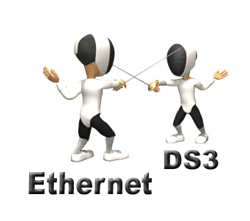For businesses that have outgrown their T1 lines, DS3 connections have been the typical upgrade option. However, there’s a new service offering greater bandwidth at a lower cost than DS3, along with a straightforward upgrade path: 50 Mbps Ethernet.
Let’s examine why DS3 became a popular bandwidth service and why Carrier Ethernet will likely replace it. A DS3, sometimes called a T3 line, offers 28 times the bandwidth of a T1, not simply three times. Upgrading from a 1.5 Mbps T1 line to a DS3 service gets you approximately 45 Mbps. Keep in mind that these figures are rounded, and overhead bits are needed to manage a DS3 circuit.
T1 and DS3 belong to the same technology family, as indicated by the alternative name “T3 line” for DS3. The “T” designation originates from “T-Carrier,” a set of post-WWII phone company standards for digitizing analog telephone trunks. T-Carrier specifications are based on a 64 Kbps channel called DS0 (Digital Signal level 0). A DS1 consists of 24 DS0 channels, equaling 1.536 Mbps, plus 8 Kbps for synchronization and maintenance, totaling 1.544 Mbps – the T1 line speed.
Similarly, a T3 line comprises DS0 channels at its core. The significance of DS0 lies in its perfect size for carrying one digitized phone call. These channels can also transmit data packets instead of voice calls. Combining 672 DS0 channels with synchronization and maintenance bits results in a 44.736 Mbps DS3, which is the T3 line speed.
T1 lines were designed for delivery over two pairs of standard twisted-pair copper telephone wiring within a multi-pair binder cable. T3 lines, on the other hand, were intended for coaxial copper or microwave transmission. Today, fiber optic cable is commonly used to carry DS3 and higher bandwidth services. Bonded copper pairs might suffice for short distances but are mainly found in densely populated areas.
Upgrading from T1 to DS3 is a substantial undertaking that involves equipment replacement, potentially significant construction costs, and a considerable jump in monthly lease fees. Once you hit the bandwidth limit of a DS3, you need to move up to OC3, the next compatible service level, offering 155.52 Mbps.
The competition for T1, DS3, OC3, and beyond comes from a different network service family: Carrier Ethernet, also known as Metro Ethernet. Carrier Ethernet shares more similarities with LAN Ethernet than with T-Carrier technology. While T-Carrier was designed for voice call transmission, Ethernet was created for data packet transport. Of course, Ethernet can also carry voice calls effectively, particularly in converged voice and data networks. An Ethernet connection used for phone traffic is often referred to as a SIP Trunk.
Now, let’s explore the replacements for the outdated T-Carrier system. Ethernet over Copper (EoC) is a direct substitute for T1 lines, offering two key advantages. First, it provides higher bandwidth – a 2 or 3 Mbps EoC service replaces a 1.5 Mbps T1 line at roughly the same cost. Moreover, you can upgrade to 10 or 20 Mbps over copper for increased bandwidth when needed.
Replacing DS3 or T3 lines is 50 Mbps Ethernet. This upgrade offers a moderate bandwidth increase and potentially significant savings on your monthly line service bill. It’s not unusual to pay 50% less (or even lower) for 50 Mbps Ethernet compared to DS3.
Both services necessitate a fiber optic connection. Since there’s no standard fiber service operating at DS3 speed, it’s delivered via a SONET OC3 service using only a third of the available bandwidth. In contrast, Ethernet offers greater scalability. While 10 Mbps, 100 Mbps, and 1000 Mbps are standard network speeds, you can obtain various increments within these levels.
A good approach is to order the Ethernet bandwidth you need currently, considering easy upgrades to incrementally higher speeds later. The key is having an Ethernet port capable of handling your anticipated maximum bandwidth. For instance, a 100 Mbps port allows you to start with 50 Mbps Ethernet and upgrade to the full 100 Mbps capacity as needed. This can often be accomplished quickly and easily with a simple call to your service provider.
If you foresee a significant WAN bandwidth upgrade or are currently using DS3 service and seeking more bandwidth or lower costs, get 50 Mbps Ethernet pricing and availability before making any decisions. This service can serve you well for years to come and offer compelling cost savings.


